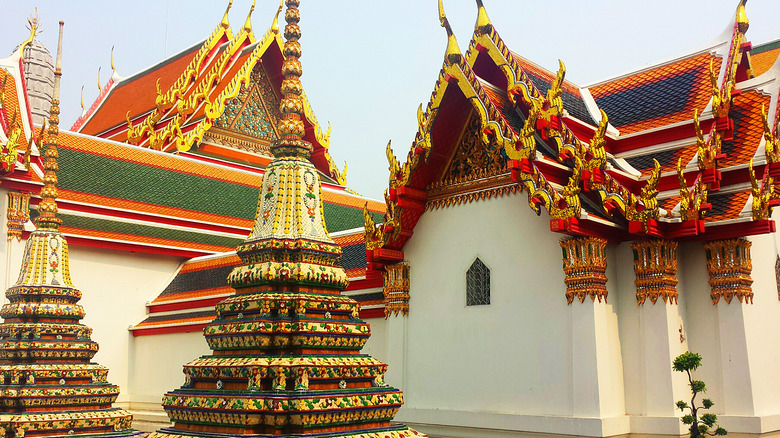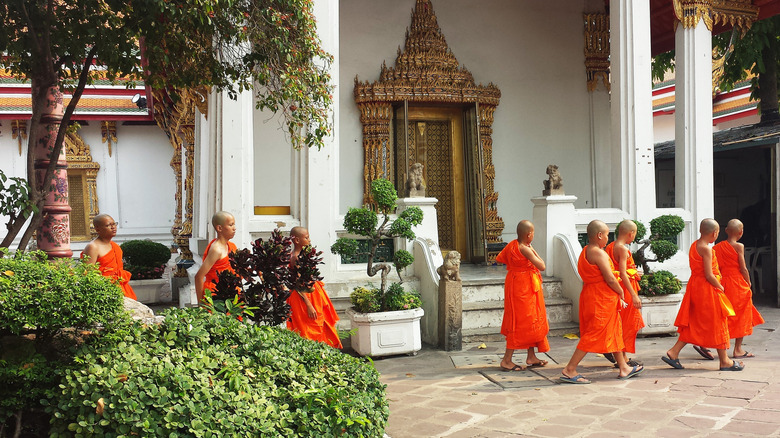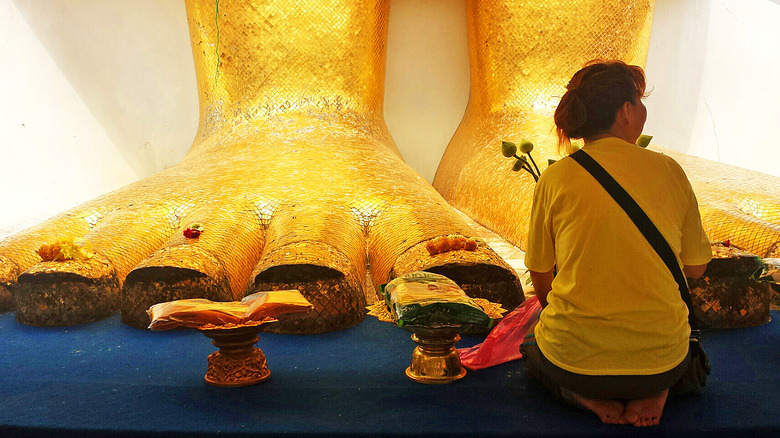Etiquette Rules You Need To Know Before Visiting A Temple In Thailand
Thailand is a stunning Southeast Asian country and is home to some of the friendliest people in the world. The best places to visit in Thailand teem with beautiful sandy beaches, crystal turquoise waters, and stunning islands. The country also has a bustling nightlife in places like Patong Beach and Bangkok. The Land of Smiles, as welcoming as it is, does not tolerate inappropriate tourist behavior, especially in and around its temples. As such, it is important to know some etiquette rules before visiting a temple to avoid cultural blunders.
Thai people are deeply proud of their majority Buddhist culture, heritage, and customs, which are quite evident throughout the country. This is more than enough reason to read the crucial details every traveler should know before booking a trip to Thailand. Taking the time to educate yourself about its customs and culture will make the difference between the Thai people welcoming you with open arms and being barred from entry to a temple for being too loud. I certainly picked up a rule or two during my travels to this beautiful country more than a decade ago.
Whether you're looking to visit Bangkok to experience its crazy nightlife or take a relaxing couples beach vacation to this spectacular island destination, you'll most definitely want to make sure you don't offend locals by disrespecting their culture. If you're about to book a trip to Thailand, keep in mind that temples, or wats as they're called, are places of worship. Therefore, regardless of your religion or beliefs, it's important to be mindful of your surroundings and behavior.
Everything you need to know before visiting a temple in Thailand
As travelers, we all want to make a great impression on locals and don't want to be dubbed "that tourist from that country." While traveling in Thailand, and after making a few blunders, I quickly understood which behaviors were acceptable, expected, or completely frowned upon. This is especially true when it comes to temple etiquette.
Just as you should cover up at any religious site out of respect, temples are no different. We emphasized this in our write-up on why tourists should be cautious about the clothing they pack for Thailand. Don't risk being denied entry for showing too much skin. In Thailand, to enter temples, you must dress conservatively and cover both shoulders and knees, and yes, this goes for males and females. Sure, with scorching heat and high humidity, you may be less than comfortable; however, you won't attract unwanted stares from locals.
Typically, shawls or cover-ups may be provided for a rental fee to those who aren't draped enough to enter, but to avoid this cost, packing a sarong can double as a great alternative if need be. You'll also want to remove your shoes as a sign of respect before entering a wat. These are typically left at the bottom of the stairs leading into a temple. In some popular areas, such as Bangkok, I was told that it was okay to place my sandals inside my bag, as shoe theft is a common occurrence in touristy areas.
Other ways to make sure you don't get frowned at while visiting temples in the Land of Smiles
According to the Tourism Authority of Thailand, there are over 40,000 temples in Thailand, with approximately 37,000 currently in use. That's a lot of temple hopping! As it may be tempting to visit many wats during your travels, you may find it just as appealing to take a selfie with Buddha inside the temple. This is a big no-no. While it is okay to take photos, never turn your back to Buddha, as it is considered disrespectful.
Another thing to take into consideration while visiting temples in Thailand is your noise level. Temples are quiet places of worship and homes to practicing monks. During my visit to Wat Pho in Bangkok, a group of curious young monks dressed in traditional attire approached me to say hello. While it may be tempting to shake their hands to greet them, it is important not to touch them and only greet them with a wai, which is done by pressing your palms together in a prayer position.
Furthermore, think twice before pointing at anything inside a temple; it is considered rude in Thai culture. If you want to do so, raise your right palm upward and toward what you want to point out. Being mindful of where you are exploring inside a wat is important as well. Many areas may be off limits to visitors and designated for monks only. Don't let cultural rules make you feel apprehensive. With a little research and preparation, you'll be ready to visit all the wats you want.


